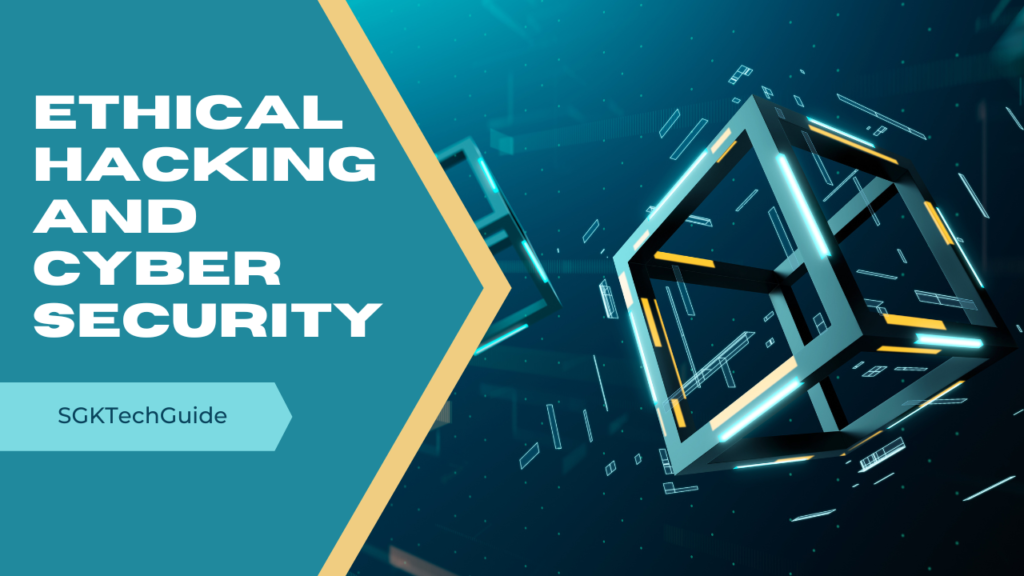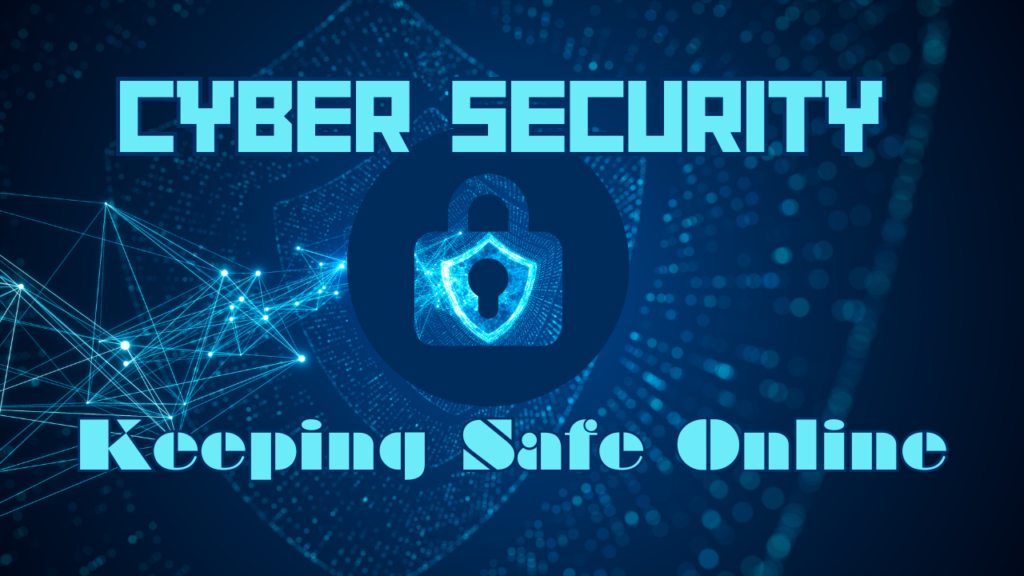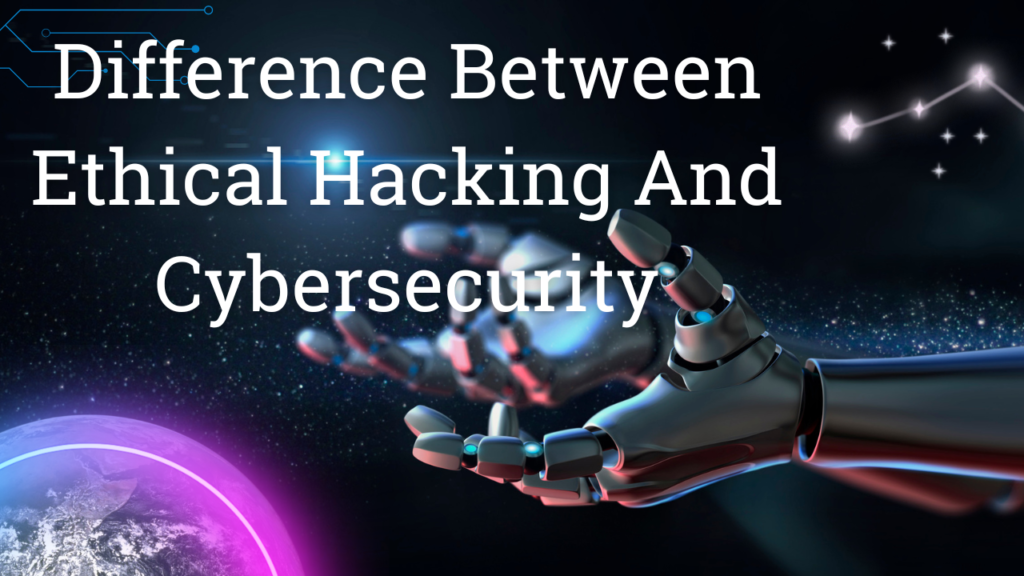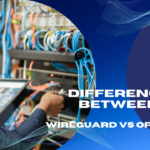Table of Contents

Introduction: the difference between ethical hacking and cybersecurity
Difference between ethical hacking and cybersecurity ethical hacking and cybersecurity. As our dependence on digital technologies deepens, the need for robust defense mechanisms against cyber threats becomes paramount. Ethical hacking, also known as penetration testing or white hat hacking, involves authorized and controlled attempts to exploit vulnerabilities in computer systems, networks, or applications. In contrast, cybersecurity encompasses a broader spectrum of measures, practices, and technologies dedicated to protecting digital assets from unauthorized access, cyber-attacks, and data breaches.
Ethical hacking serves as a strategic offense within the cybersecurity framework, allowing organizations to proactively identify and address potential weaknesses before they can be exploited by malicious actors. The objectives of ethical hacking include conducting vulnerability assessments, executing penetration tests, and ultimately improving security postures. The skill set of ethical hackers is characterized by technical proficiency, problem-solving acumen, and a commitment to continuous learning to stay ahead of emerging cyber threats.
In contrast, cybersecurity adopts a holistic defense approach, seeking to manage risks, respond to incidents, develop security policies, and enhance overall security awareness. The professionals in this field possess a diverse skill set, including policy development, risk management, incident response, and effective communication. Together, ethical hacking and cybersecurity form a symbiotic relationship, where the proactive testing provided by ethical hacking informs and strengthens the broader defensive strategies implemented in the realm of cybersecurity. This blog post will delve into the nuances of these two critical components, unraveling their differences and exploring how their collaboration creates a resilient defense against the ever-evolving cyber threat landscape.
Ethical Hacking: A Strategic Offense
In the dynamic realm of cybersecurity, where the battle between defenders and adversaries rages on, ethical hacking emerges as a potent strategic offense. Also known as penetration testing or white hat hacking, ethical hacking represents a proactive and authorized approach to identifying vulnerabilities within digital systems before malicious actors can exploit them. It is a tactical and controlled offensive maneuver undertaken by cybersecurity experts to fortify the digital fortresses that safeguard our interconnected world.
The fundamental premise of ethical hacking is to emulate the tactics, techniques, and procedures employed by cyber adversaries with the explicit goal of enhancing an organization’s security posture. Ethical hackers meticulously assess networks, applications, and computer systems, employing a diverse set of tools and methodologies to uncover potential weaknesses. Unlike malicious hackers who seek to exploit vulnerabilities for personal gain, ethical hackers operate within legal and ethical boundaries, obtaining explicit permission to test and strengthen defenses. This strategic offense plays a pivotal role in fortifying digital infrastructures, ensuring that security vulnerabilities are identified, analyzed, and remediated before they can be leveraged for malicious purposes.
The objectives of ethical hacking extend beyond the mere identification of vulnerabilities. Ethical hackers engage in comprehensive vulnerability assessments, execute penetration tests, and provide valuable insights into potential weaknesses that could compromise the integrity, confidentiality, or availability of digital assets. As technology advances and cyber threats become more sophisticated, the strategic offense of ethical hacking becomes an indispensable element in the broader landscape of cybersecurity. It stands as a proactive shield, arming organizations with the knowledge and measures needed to stay one step ahead in the ongoing battle against cyber threats.
Key Objectives of Ethical Hacking
Ethical hacking, as a strategic offensive measure within the cybersecurity framework, is driven by a set of well-defined objectives aimed at fortifying digital defenses and ensuring the resilience of information systems. Ethical hackers, armed with explicit authorization, embark on a mission that goes beyond merely identifying vulnerabilities—they seek to address weaknesses comprehensively, enhance security postures, and contribute to the overarching goal of safeguarding sensitive information in an increasingly interconnected world.
-
Vulnerability Assessment:
- At the core of ethical hacking lies the objective of conducting meticulous vulnerability assessments. Ethical hackers systematically scan and analyze computer systems, networks, and applications to pinpoint potential weaknesses. This process involves identifying vulnerabilities that could serve as entry points for unauthorized access, data breaches, or other cyber threats.
-
Penetration Testing:
- Ethical hackers simulate real-world cyber attacks through penetration testing. This objective involves actively exploiting identified vulnerabilities to gauge the effectiveness of existing security measures. By emulating the tactics of malicious actors, ethical hackers provide organizations with critical insights into how well their systems can withstand various forms of cyber threats.
-
Security Improvement:
- Beyond identification and testing, the primary goal of ethical hacking is to contribute to the improvement of security postures. Ethical hackers provide organizations with actionable recommendations and strategies to address identified vulnerabilities. This objective ensures that security measures are not only reactive but also proactive, fortifying digital infrastructures against potential threats.
-
Legal and Authorized Practices:
- Unlike malicious hackers, ethical hackers operate within strict legal and ethical boundaries. Obtaining explicit permission from organizations, ethical hacking is conducted in a controlled environment to prevent any unintended consequences. This objective ensures that the strategic offense aligns with the principles of responsible and lawful cybersecurity practices.
-
Continuous Learning and Adaptability:
- Ethical hacking is an ever-evolving field, and one of its key objectives is to stay abreast of the latest cyber threats and technological advancements. Ethical hackers commit to continuous learning, adapting their skills and methodologies to counter emerging threats effectively. This objective ensures that ethical hacking remains a dynamic and proactive force in the face of evolving cybersecurity challenges.
In essence, the key objectives of ethical hacking converge on the proactive identification, testing, and remediation of vulnerabilities. By fulfilling these objectives, ethical hackers contribute not only to the immediate security of organizations but also to the overarching resilience of the digital ecosystem. Ethical hacking serves as a strategic offensive measure that empowers organizations to stay ahead in the perpetual cat-and-mouse game against cyber threats.
Scal hackers, often regarded as cybersecurity guardians, wield a distinctive skill set that sets them apart in the dynamic landscape of information security. Charged with the responsibility of identifying vulnerabilities, fortifying digital defenses, and staying one step ahead of cyber adversaries, ethical hackers possess a multifaceted skill set that combines technical prowess, problem-solving acumen, and a commitment to continuous learning. Here’s an exploration of the key skills that define the capabilities of ethical hackers.

Skill Set of Ethical Hackers
Ethical hackers, often regarded as cybersecurity guardians, wield a distinctive skill set that sets them apart in the dynamic landscape of information security. Charged with the responsibility of identifying vulnerabilities, fortifying digital defenses, and staying one step ahead of cyber adversaries, ethical hackers possess a multifaceted skill set that combines technical prowess, problem-solving acumen, and a commitment to continuous learning. Here’s an exploration of the key skills that define the capabilities of ethical hackers.
-
Technical Proficiency:
- At the heart of an ethical hacker’s skill set lies a deep and comprehensive understanding of computer systems, networks, and security protocols. Ethical hackers possess expertise in various operating systems, programming languages, and network architectures. This technical proficiency enables them to navigate complex environments and identify potential vulnerabilities with precision.
-
Problem-Solving Skills:
- Ethical hackers are adept problem solvers who approach cybersecurity challenges with analytical thinking and strategic foresight. They must unravel intricate security puzzles, simulate real-world cyber threats, and devise effective solutions to fortify digital systems. This skill is crucial in identifying vulnerabilities and recommending robust security measures.
-
Continuous Learning and Adaptability:
- The landscape of cybersecurity is ever-evolving, with new threats emerging regularly. Ethical hackers exhibit a commitment to continuous learning, and staying informed about the latest cybersecurity trends, vulnerabilities, and hacking techniques. This skill ensures that ethical hackers remain agile and adaptable, ready to counteract emerging threats effectively.
-
Programming and Scripting Skills:
- Proficiency in programming languages and scripting is essential for ethical hackers. Whether it’s crafting custom exploits, analyzing code for vulnerabilities, or automating security tasks, ethical hackers leverage programming skills to enhance the efficiency and effectiveness of their assessments.
-
Networking Fundamentals:
- Understanding networking principles is fundamental for ethical hackers. From analyzing network traffic to identifying potential entry points, a solid grasp of networking fundamentals allows ethical hackers to navigate and assess the intricacies of interconnected systems.
-
Hands-On Experience:
- Ethical hackers often gain practical experience through hands-on activities, such as labs, capture-the-flag (CTF) challenges, and real-world simulations. This practical exposure hones their skills, allowing them to apply theoretical knowledge in dynamic and realistic scenarios.
-
Attention to Detail:
- Cyber threats often lurk in the details. Ethical hackers exhibit a keen attention to detail, meticulously examining system configurations, log files, and code to uncover subtle vulnerabilities that could be exploited by malicious actors.
-
Communication Skills:
- Effectively communicating findings and recommendations is a crucial aspect of an ethical hacker’s role. Strong written and verbal communication skills enable ethical hackers to convey complex technical information to diverse audiences, including non-technical stakeholders.
-
Ethical Mindset:
- Perhaps the most critical skill is the cultivation of an ethical mindset. Ethical hackers operate within legal and ethical boundaries, ensuring that their actions align with responsible and lawful cybersecurity practices. This ethical foundation distinguishes them from malicious hackers and underscores the integrity of their work.
In summary, the skill set of ethical hackers encompasses a blend of technical expertise, problem-solving capabilities, continuous learning, and an unwavering commitment to ethical conduct. These skills collectively empower ethical hackers to navigate the intricate landscape of cybersecurity, identify vulnerabilities, and fortify digital defenses against an ever-evolving array of cyber threats.

Cybersecurity: The Holistic Defense
In an era defined by digital interconnectivity, the safeguarding of digital assets, sensitive information, and critical systems has become a paramount concern. Cybersecurity, as a comprehensive and multifaceted discipline, stands as the bedrock of defense against a myriad of cyber threats. It encompasses a holistic approach that extends beyond mere protective measures, delving into risk management, incident response, policy development, and the cultivation of a resilient security culture. Let’s delve into the core aspects that define cybersecurity as a holistic defense strategy.
-
Defining Cybersecurity:
- At its essence, cybersecurity is the practice of protecting computer systems, networks, and data from unauthorized access, attacks, and damage. It encompasses a proactive and reactive approach to securing digital environments against an ever-evolving landscape of cyber threats.
-
Broader Scope and Objectives:
- Unlike ethical hacking, which focuses on controlled offensive measures, cybersecurity adopts a broader scope. Its objectives span a spectrum of protective measures that go beyond vulnerability identification and penetration testing. Cybersecurity aims to ensure the confidentiality, integrity, and availability of information in the face of diverse cyber threats.
-
Proactive Measures against Cyber Threats:
- Cybersecurity entails a proactive stance against potential threats. This includes implementing preventive measures such as firewalls, intrusion detection systems, and encryption protocols to fortify digital perimeters and thwart unauthorized access attempts before they materialize into security incidents.
-
Risk Management:
- An integral component of cybersecurity is the assessment and management of risks. This involves identifying potential vulnerabilities, evaluating the likelihood and impact of cyber threats, and implementing strategies to mitigate risks effectively. Risk management ensures a nuanced and strategic approach to securing digital assets.
-
Incident Response:
- Cybersecurity is not solely about prevention; it also involves preparing for and responding to security incidents. Incident response plans are developed to outline strategies for detecting, containing, and eradicating cyber threats promptly. This aspect ensures a swift and effective response in the event of a security breach.
-
Policy Development:
- Establishing robust security policies and protocols is a cornerstone of cybersecurity. These policies guide organizational practices, outlining acceptable use, data handling procedures, and security best practices. Well-defined policies contribute to a cohesive and standardized approach to cybersecurity within an organization.
-
Security Awareness:
- Educating users and stakeholders about cybersecurity best practices is a fundamental aspect of the holistic defense approach. Security awareness programs foster a culture of vigilance and responsibility, empowering individuals within an organization to play an active role in maintaining a secure digital environment.
-
Adaptive Strategies:
- Cyber threats are dynamic, requiring cybersecurity professionals to adopt adaptive strategies. This involves staying informed about emerging threats, leveraging threat intelligence, and continuously updating security measures to address new vulnerabilities and attack vectors.
In conclusion, cybersecurity stands as a holistic defense mechanism that extends far beyond the confines of any single protective measure. It embraces a proactive and reactive approach, addressing risks, responding to incidents, developing policies, and cultivating a culture of security awareness. As organizations navigate the complexities of an interconnected digital landscape, cybersecurity remains an indispensable guardian, ensuring the resilience and integrity of digital infrastructures against a spectrum of cyber threats.
Key Objectives of Cybersecurity
Cybersecurity, as the vanguard of digital defense, is characterized by a set of key objectives aimed at safeguarding digital assets, sensitive information, and critical systems from a diverse range of cyber threats. In an era where cyber adversaries continually evolve their tactics, the objectives of cybersecurity go beyond reactive measures, emphasizing a proactive and comprehensive approach to ensure the confidentiality, integrity, and availability of information. Let’s explore the fundamental objectives that define the realm of cybersecurity.
-
Risk Management:
- One of the primary objectives of cybersecurity is the assessment and management of risks. This involves identifying potential vulnerabilities, evaluating the likelihood and impact of cyber threats, and implementing strategies to mitigate risks effectively. By understanding and managing risks, cybersecurity professionals can tailor their defensive measures to the specific threat landscape.
-
Incident Response:
- Cybersecurity aims to prepare for and respond effectively to security incidents. Incident response plans are developed to outline strategies for detecting, containing, eradicating, and recovering from security breaches. Rapid and efficient incident response is crucial to minimizing the impact of security incidents and restoring normal operations swiftly.
-
Policy Development:
- Establishing robust security policies and protocols is a cornerstone of cybersecurity. These policies guide organizational practices, outlining acceptable use, data handling procedures, and security best practices. Well-defined policies contribute to a cohesive and standardized approach to cybersecurity within an organization, ensuring a consistent and accountable security posture.
-
Security Awareness:
- Educating users and stakeholders about cybersecurity best practices is a fundamental objective. Security awareness programs foster a culture of vigilance and responsibility, empowering individuals within an organization to recognize and respond to potential threats. Informed and vigilant users serve as an additional layer of defense against social engineering and other cyber threats.
-
Proactive Measures:
- Cybersecurity involves the implementation of proactive measures to prevent unauthorized access, data breaches, and other cyber threats. This includes deploying technologies such as firewalls, intrusion detection systems, and encryption protocols to fortify digital perimeters and thwart potential threats before they materialize into security incidents.
-
Continuous Monitoring:
- Cybersecurity professionals continuously monitor networks, systems, and applications for anomalous activities. This objective ensures the early detection of potential security incidents, enabling a swift response to mitigate risks. Continuous monitoring is crucial in an environment where cyber threats are persistent and ever-evolving.
-
Compliance and Regulation:
- Adhering to industry regulations and compliance standards is an integral aspect of cybersecurity. Organizations must align their security practices with established standards to meet legal requirements and industry-specific regulations. This objective ensures that cybersecurity measures are not only effective but also compliant with applicable laws and standards.
-
Adaptive Strategies:
- Cyber threats are dynamic and continually evolving. Therefore, cybersecurity objectives include staying informed about emerging threats, leveraging threat intelligence, and continuously updating security measures to address new vulnerabilities and attack vectors. Adaptive strategies ensure that cybersecurity defenses remain resilient in the face of evolving threats.
In summary, the key objectives of cybersecurity collectively form a comprehensive and proactive defense strategy. From managing risks and responding to incidents to developing policies and fostering security awareness, these objectives reflect the multifaceted nature of cybersecurity as it endeavors to protect and fortify digital ecosystems against a dynamic and ever-present cyber threat landscape.
Skill Set of Cybersecurity Professionals
In the complex and ever-evolving landscape of cybersecurity, professionals are tasked with the critical responsibility of safeguarding digital assets against an array of cyber threats. The efficacy of these defenders hinges on a versatile skill set that spans technical expertise, strategic thinking, and a commitment to staying ahead of emerging threats. Here’s an exploration of the essential skills that define cybersecurity professionals and empower them to navigate the dynamic challenges of the digital realm.
-
Technical Proficiency:
- A foundational skill for cybersecurity professionals is technical proficiency. This encompasses a deep understanding of computer systems, networks, operating systems, and security protocols. Proficient professionals can navigate intricate technical landscapes, analyze vulnerabilities, and implement effective security measures.
-
Risk Management:
- Cybersecurity professionals must possess a keen understanding of risk management principles. This involves identifying potential vulnerabilities, evaluating the likelihood and impact of cyber threats, and developing strategies to mitigate risks effectively. The ability to make informed decisions based on risk assessments is crucial in fortifying digital defenses.
-
Incident Response:
- Rapid and effective incident response is a critical skill in the cybersecurity arsenal. Professionals should be adept at developing and executing incident response plans, enabling them to detect, contain, eradicate, and recover from security incidents promptly. This skill ensures minimal disruption and damage in the event of a cyber attack.
-
Policy Development:
- Establishing and implementing robust security policies is an essential aspect of cybersecurity. Professionals need to develop comprehensive policies and protocols that guide organizational practices, outline acceptable use, and establish security best practices. Well-defined policies contribute to a consistent and standardized security posture.
-
Security Awareness:
- Communication skills are vital for cybersecurity professionals to effectively convey complex technical information to a diverse audience. This includes educating users and stakeholders about cybersecurity best practices through security awareness programs. The ability to foster a culture of vigilance and responsibility is crucial in mitigating social engineering and other human-centric threats.
-
Networking Fundamentals:
- Understanding networking principles is fundamental for cybersecurity professionals. This skill allows them to analyze network traffic, identify potential entry points for attackers, and navigate the intricacies of interconnected systems. Networking fundamentals are essential for developing effective security measures and responding to network-based threats.
-
Continuous Learning:
- Given the dynamic nature of cyber threats, a commitment to continuous learning is a hallmark of cybersecurity professionals. Staying informed about emerging threats, new technologies, and evolving attack methodologies is crucial. This skill ensures that professionals remain adaptive and proactive in the face of an ever-changing threat landscape.
-
Analytical Thinking:
- Cybersecurity professionals need strong analytical skills to dissect complex security issues, assess vulnerabilities, and devise effective solutions. Analytical thinking is crucial for problem-solving in dynamic and high-pressure situations, allowing professionals to make informed decisions that fortify digital defenses.
-
Adaptive Strategies:
- The ability to adapt strategies based on emerging threats is a key skill for cybersecurity professionals. This involves staying abreast of threat intelligence, understanding evolving attack vectors, and adjusting security measures accordingly. Adaptive strategies ensure that defenses remain resilient in the face of an ever-evolving cyber threat landscape.
In conclusion, the skill set of cybersecurity professionals combines technical acumen, risk management, incident response, communication, and a commitment to continuous learning. This multifaceted skill set equips professionals to navigate the intricacies of cybersecurity, ensuring the resilience and integrity of digital ecosystems against a spectrum of evolving cyber threats.
Bridging the Gap: Cooperation and Integration
In the dynamic and interconnected landscape of cybersecurity, the efficacy of defense against cyber threats relies on the seamless cooperation and integration of various components within an organization. Bridging the gap between different cybersecurity functions, teams, and technologies is essential for creating a cohesive and resilient defense strategy. This collaborative approach ensures that the collective strength of diverse elements can effectively thwart the evolving tactics of cyber adversaries. Let’s explore the significance of cooperation and integration in fortifying digital defenses.
-
Interconnected Cybersecurity Functions:
- Cybersecurity functions within an organization often operate as interconnected pieces of a larger puzzle. These functions may include risk management, incident response, policy development, ethical hacking, and more. Bridging the gap between these functions ensures a holistic approach to cybersecurity, where each component complements and reinforces the others.
-
Communication and Information Sharing:
- Effective communication is a linchpin in bridging the gap between different cybersecurity elements. Information sharing among teams facilitates a real-time understanding of emerging threats, ongoing security incidents, and vulnerabilities. This collaborative exchange ensures that all stakeholders are well-informed and can respond promptly to potential risks.
-
Coordinated Incident Response:
- Cybersecurity incidents require swift and coordinated responses. Bridging the gap between incident response teams, IT departments, and other relevant stakeholders ensures a seamless and well-coordinated response to security incidents. This collaborative effort minimizes downtime, mitigates damage, and facilitates a rapid return to normal operations.
-
Integration of Technologies:
- Bridging the gap extends to the integration of cybersecurity technologies. Security tools, such as firewalls, intrusion detection systems, and antivirus solutions, should work in concert to create a comprehensive defense. Integrating these technologies allows for a more sophisticated and layered defense strategy, making it challenging for adversaries to breach digital perimeters.
-
Cross-Functional Training:
- Cross-functional training programs play a crucial role in bridging the gap between different cybersecurity teams. When professionals from various functions undergo training that exposes them to the responsibilities and challenges of other teams, it fosters a deeper understanding and appreciation for the roles each plays in the overall cybersecurity posture.
-
Strategic Alignment with Business Goals:
- Bridging the gap between cybersecurity and the broader business objectives is essential. Security measures should be aligned with the strategic goals of the organization, ensuring that cybersecurity investments contribute to the overall success and resilience of the business. This alignment fosters support from leadership and stakeholders.
-
Continuous Collaboration:
- Cyber threats are dynamic, and so must be the collaboration between cybersecurity functions. Regular meetings, joint exercises, and continuous collaboration efforts ensure that teams remain synchronized and can adapt swiftly to changes in the threat landscape. This ongoing collaboration is essential for maintaining a proactive and adaptive defense strategy.
-
Threat Intelligence Sharing:
- Bridging the gap involves sharing threat intelligence not only within an organization but also across the broader cybersecurity community. Collaborative threat intelligence sharing allows organizations to benefit from collective knowledge, identify emerging threats, and collectively fortify defenses on a global scale.
In conclusion, bridging the gap through cooperation and integration is fundamental for creating a robust cybersecurity defense. The synergy of interconnected functions, effective communication, technology integration, and strategic alignment ensures that organizations can collectively stand resilient against the diverse and sophisticated challenges posed by cyber threats. In the face of a dynamic threat landscape, this collaborative approach becomes a cornerstone for success in safeguarding digital assets and maintaining the integrity of digital ecosystems.
Conclusion: the difference between ethical hacking and cybersecurity
ethical hacking and cybersecurity emerge not as isolated entities but as complementary forces in the ongoing battle against cyber threats. While ethical hacking represents the tactical offensive—proactively identifying and addressing vulnerabilities—cybersecurity stands as the overarching defense, encompassing a broader spectrum of protective measures. Together, they form a symbiotic relationship, where the insights gained from ethical hacking inform and fortify the strategic, proactive, and holistic approach of cybersecurity. This collaboration ensures that organizations navigate the ever-evolving threat landscape with resilience, staying one step ahead in the ceaseless pursuit of digital safety.
In the intricate dance between ethical hacking and cybersecurity, the synthesis of offensive testing and defensive fortification becomes a linchpin for digital resilience. Ethical hacking’s targeted probes illuminate the vulnerabilities that cybersecurity endeavors to fortify, creating a continuous cycle of improvement. As defenders and assailants coalesce in purpose—protecting the integrity of digital ecosystems—their collaboration becomes indispensable for organizations striving to maintain the confidentiality, integrity, and availability of information in our interconnected world.








